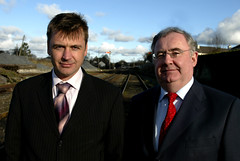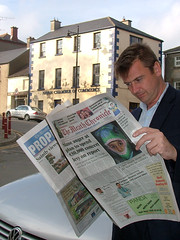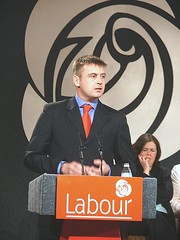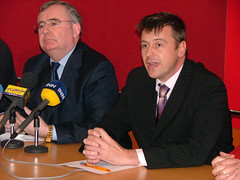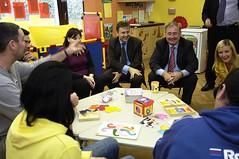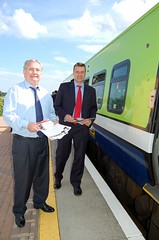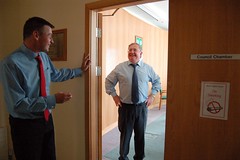Tuesday, April 14, 2009
Love and Peace in Bolivia
“El amor y la paz” is the greeting we receive from the gang leader as we enter the small clearing beside the ring road. Straight ahead was a tiny shack, the territory of the band of homeless youths we were visiting. “El amor y la paz” we shout back.
Around the clearing the scene was one of decay. Burnt rubbish and mangy dogs were scattered around. So too were the plastic bottles which used to contain the particular brand of glue that is the staple diet of the street kids of the city of Cochabamba in Bolivia.
The gang leader beckoned us into the shack. I was accompanying Saul, a local youth worker. We stepped from the bright morning sunshine into the darkness of the small, kitchen-sized room. I gasped and tried not to wretch from the utter stink. It was so overpowering that my automatic reaction was to leave. I stayed, knowing that I would soon get used to the stench. After a few seconds my eyes adjusted to the darkness and I was facing seven youths of indeterminate age.
It was clear that a lot of them were already high on drugs, even though it was only ten am. I asked them their names. Lourdes was 23 years old with a pretty face. Already a mother, she had her child taken away from her because she was unable to care for it. Beside her sat Gabriel, who had difficulty moving about. Last year Gabriel’s leg was broken in a car accident. The medics tried to re-set it but Gabriel implied that he didn’t follow the treatment advice given to him and one year on the bone sticks out at a 45 degree angle to the rest of the leg. Gabriel is eighteen.
Saul the youth worker was treated with respect by the gang family. They are one of many gang families in Cochabamba, a city the size of Cork. These gangs range in size from ten to thirty youths and the members look out for each other, much the way a family would. Indeed, Gabriel’s younger sister was also a member of his gang. These youths come from broken homes, or are unwanted, or leave home because despite the harshness of life on the street, they consider it to be more preferable than life with their parents. Once they hit the streets they are exposed to the small bottles of the toxic glue, which they buy for less than a dollar.
Saul visits all of the gang families. He works for a local charity CIES, which provides outreach support and runs a clinic offering medical attention. Saul’s job is to try and make sure that they receive medical attention for any illnesses that they have, as well as helping to provide information on sexual and reproductive health. He also works with other agencies to try to get the kids back into settled accommodation. For just $700,000 per annum, this project runs in Cochabamba and other cities in Bolivia, and also in Peru and Guatemala.
Although the number of street boys outnumbers the number of street girls, there are still a large number of girls on the street. According to Saul virtually all of them will have been raped either by members of the gangs or through prostitution. We visited a group where one girl sat amongst a gang of ten boys. Because of her severe overuse of solvents she has lost the power of her legs. Every few hours the group gets moved on by the police and her friends carry her over to their next gathering spot.
Her inability to walk also means that she can’t get to a public toilet on her own. Her one request to Saul was for some diapers, as she had none left that she could use. Beside her lay a kid in obvious discomfort. He threw back a filthy blanket and pulled up the leg of his pants to show us a large oozing sore just below his knee.
His friend beside him asked Saul for medical help for the leg. Saul told him to bring the kid along to the CIES clinic in the afternoon, but told them both to refrain from sniffing any more glue until then. Later in the clinic Saul gave us a presentation, during which he explained that it’s their policy to ask the kids not to come in for treatment when they are under the influence: they want to get the kids to keep off the glue for as long as possible. That’s a difficult thing to do when the rest of your gang family are all abusing on a regular basis and when live on the streets of Cochabamba is so tough.
After the presentation we were shown around the clinic. In one room a young man taught a group of twenty students about sexual health. These students will go around the schools and colleges of Cochabamba to educate their fellow students on sexual health issues. All the evidence is that such peer education has a dramatic impact on getting the message through to other young people in the community. This work also forms part of the CIES project, as does a programme to train women in empowerment issues.
Saul brought us over to the boy with the ulcerous leg that we had seen in the morning. All of us felt some relief that he was getting the medical attention which he clearly needed. He wouldn’t get it if it wasn’t for contributions from the development aid budgets of organisations such as USAID and the European Union. Clinic staff told us that despite promises from the local politicians to address the issue of homelessness it appears that little has been done. Local and central Government expenditure on public health care is too low to be able to meet the needs of these street kids.
But there’s currently no space on the political agenda for these street kids, because Bolivia itself is at a turning point. President Evo Morales recently won a referendum to introduce a new constitution. A socialist in the mould of Chavez in Venezuela, Lula in Brazil and Castro in Cuba, “Evo” is intend on redrafting mounds of legislation to ensure that the majority indigenous people in Bolivia have the same rights as the rest of the Bolivian population. That includes the right to health and his intention is that 10% of GDP will be spent on the health service.
The new constitution contains many aspirational aims such as this. New laws will be required to implement the thrust of the constitution. Changes to society are expected to be huge, and expectations among the poorer indigenous population run high. Evo will have a difficult balancing act to satisfy their expectations whilst at the same time ensuring that he takes the rest of the population along on the journey to his new Bolivia. Failure to do so could result in civil unrest and potential secession of some of the states.
Omnipresent in Bolivia is graffiti stating “Evo Si” or “Evo No”. His picture is everywhere and the subject of the political future of Bolivia is the only conversation in town. And because the whole local and national political establishment is caught up in the big picture issues there is scant attention being paid to the invisibles on the streets.
Saul has been working with the street kids for the last five years. He’s seen some success but he admits that there have been many other failures. He says that if he doesn’t rescue the street kid before he or she reaches eighteen then there’s little chance that they will be rehabilitated back into Bolivian society. He reckons that the average length of time a kid can spend on the street is about ten years. Then they perish because of disease, drug overdose or violence. When that happens the last thing he does for them is organise a collection within his office to help pay for the cost of a burial.
But now his job is on the line. The project is funded through various international charities and it comes to an end in June. Unless more funding comes from international aid budgets the project will shut down. He’ll have to find another job – tough enough in a country with 25% unemployment but Saul has the ability to pull through. What happens to the street kids of Cochabamba is likely to be a lot sadder.
I spent St Patrick’s Week in Bolivia with the Irish Family Planning Association and the International Planned Parenthood Federation.
Around the clearing the scene was one of decay. Burnt rubbish and mangy dogs were scattered around. So too were the plastic bottles which used to contain the particular brand of glue that is the staple diet of the street kids of the city of Cochabamba in Bolivia.
The gang leader beckoned us into the shack. I was accompanying Saul, a local youth worker. We stepped from the bright morning sunshine into the darkness of the small, kitchen-sized room. I gasped and tried not to wretch from the utter stink. It was so overpowering that my automatic reaction was to leave. I stayed, knowing that I would soon get used to the stench. After a few seconds my eyes adjusted to the darkness and I was facing seven youths of indeterminate age.
It was clear that a lot of them were already high on drugs, even though it was only ten am. I asked them their names. Lourdes was 23 years old with a pretty face. Already a mother, she had her child taken away from her because she was unable to care for it. Beside her sat Gabriel, who had difficulty moving about. Last year Gabriel’s leg was broken in a car accident. The medics tried to re-set it but Gabriel implied that he didn’t follow the treatment advice given to him and one year on the bone sticks out at a 45 degree angle to the rest of the leg. Gabriel is eighteen.
Saul the youth worker was treated with respect by the gang family. They are one of many gang families in Cochabamba, a city the size of Cork. These gangs range in size from ten to thirty youths and the members look out for each other, much the way a family would. Indeed, Gabriel’s younger sister was also a member of his gang. These youths come from broken homes, or are unwanted, or leave home because despite the harshness of life on the street, they consider it to be more preferable than life with their parents. Once they hit the streets they are exposed to the small bottles of the toxic glue, which they buy for less than a dollar.
Saul visits all of the gang families. He works for a local charity CIES, which provides outreach support and runs a clinic offering medical attention. Saul’s job is to try and make sure that they receive medical attention for any illnesses that they have, as well as helping to provide information on sexual and reproductive health. He also works with other agencies to try to get the kids back into settled accommodation. For just $700,000 per annum, this project runs in Cochabamba and other cities in Bolivia, and also in Peru and Guatemala.
Although the number of street boys outnumbers the number of street girls, there are still a large number of girls on the street. According to Saul virtually all of them will have been raped either by members of the gangs or through prostitution. We visited a group where one girl sat amongst a gang of ten boys. Because of her severe overuse of solvents she has lost the power of her legs. Every few hours the group gets moved on by the police and her friends carry her over to their next gathering spot.
Her inability to walk also means that she can’t get to a public toilet on her own. Her one request to Saul was for some diapers, as she had none left that she could use. Beside her lay a kid in obvious discomfort. He threw back a filthy blanket and pulled up the leg of his pants to show us a large oozing sore just below his knee.
His friend beside him asked Saul for medical help for the leg. Saul told him to bring the kid along to the CIES clinic in the afternoon, but told them both to refrain from sniffing any more glue until then. Later in the clinic Saul gave us a presentation, during which he explained that it’s their policy to ask the kids not to come in for treatment when they are under the influence: they want to get the kids to keep off the glue for as long as possible. That’s a difficult thing to do when the rest of your gang family are all abusing on a regular basis and when live on the streets of Cochabamba is so tough.
After the presentation we were shown around the clinic. In one room a young man taught a group of twenty students about sexual health. These students will go around the schools and colleges of Cochabamba to educate their fellow students on sexual health issues. All the evidence is that such peer education has a dramatic impact on getting the message through to other young people in the community. This work also forms part of the CIES project, as does a programme to train women in empowerment issues.
Saul brought us over to the boy with the ulcerous leg that we had seen in the morning. All of us felt some relief that he was getting the medical attention which he clearly needed. He wouldn’t get it if it wasn’t for contributions from the development aid budgets of organisations such as USAID and the European Union. Clinic staff told us that despite promises from the local politicians to address the issue of homelessness it appears that little has been done. Local and central Government expenditure on public health care is too low to be able to meet the needs of these street kids.
But there’s currently no space on the political agenda for these street kids, because Bolivia itself is at a turning point. President Evo Morales recently won a referendum to introduce a new constitution. A socialist in the mould of Chavez in Venezuela, Lula in Brazil and Castro in Cuba, “Evo” is intend on redrafting mounds of legislation to ensure that the majority indigenous people in Bolivia have the same rights as the rest of the Bolivian population. That includes the right to health and his intention is that 10% of GDP will be spent on the health service.
The new constitution contains many aspirational aims such as this. New laws will be required to implement the thrust of the constitution. Changes to society are expected to be huge, and expectations among the poorer indigenous population run high. Evo will have a difficult balancing act to satisfy their expectations whilst at the same time ensuring that he takes the rest of the population along on the journey to his new Bolivia. Failure to do so could result in civil unrest and potential secession of some of the states.
Omnipresent in Bolivia is graffiti stating “Evo Si” or “Evo No”. His picture is everywhere and the subject of the political future of Bolivia is the only conversation in town. And because the whole local and national political establishment is caught up in the big picture issues there is scant attention being paid to the invisibles on the streets.
Saul has been working with the street kids for the last five years. He’s seen some success but he admits that there have been many other failures. He says that if he doesn’t rescue the street kid before he or she reaches eighteen then there’s little chance that they will be rehabilitated back into Bolivian society. He reckons that the average length of time a kid can spend on the street is about ten years. Then they perish because of disease, drug overdose or violence. When that happens the last thing he does for them is organise a collection within his office to help pay for the cost of a burial.
But now his job is on the line. The project is funded through various international charities and it comes to an end in June. Unless more funding comes from international aid budgets the project will shut down. He’ll have to find another job – tough enough in a country with 25% unemployment but Saul has the ability to pull through. What happens to the street kids of Cochabamba is likely to be a lot sadder.
I spent St Patrick’s Week in Bolivia with the Irish Family Planning Association and the International Planned Parenthood Federation.

